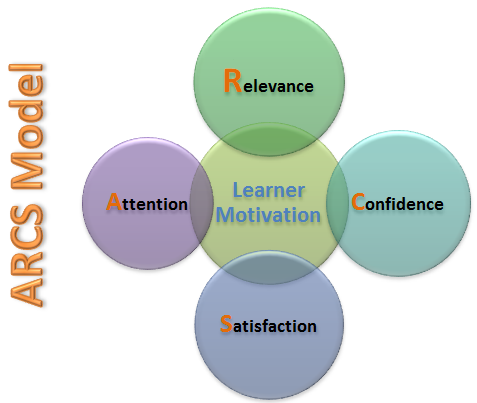Fostering Learning Online
Fostering meaningful learning online requires an understanding of online learners and their motivation to learn.
Motivation
 Keller (1991) stated that to keep learners motivated to learn instructors need to:
Keller (1991) stated that to keep learners motivated to learn instructors need to:
- gain learners attention: to gain attention you can use different instructional techniques, such as discovery learning, videoquests, twitter discussions. One other way of gaining attention may be to centre a discussion around something controversial, but relevant to the learning (e.g. newspaper articles about safety if you are teaching carpentry)
- make the content relevant: use examples and design activities that are contextual and relevant to the learners (e.g. if you are teaching auto mechanics, come up with activities that will involved fixing car breaks)
- ensure learners are confident that they can succeed in learning the course content: make sure that all activities and assessments are "doable" and present your content in manageable chunks
- satisfy the learners’ need for value in learning the material: provide timely and frequent feedback to your learners so that they have a sense of accomplishment.
Online Facilitation
The ARCS model applies not only to online course design but also to online facilitation of learning, through discussions, for example.
Tips for online facilitation
- Instructor presence: Make sure your presence as an instructor is felt throughout the course. Not just in the content you create, but also when you facilitate discussions. This doens't mean that you have to respond to every single post in the discussions, Quite the opposite - you will get more value for your postings when you post when necessary to provide guidance or to re-assure learners that they are on the right track.
- Weaving: Use the 'weaving' technique to recognize learners' contributions to the discussion, to link key concepts discussed and to pose further questions if appropriate. Weaving through contributions is an example of extrinsic motivation and may result in subsequent postings. 'Weaving' technique is based on a single reply to several postings and creates opportunities for the instructor to guide the direction of the discussions, to summarize the main points or to pose further questions to delve deeper into a topic.
- Summarizing: Summarizing the main themes that surface in a discussion helps consolidate the learning and establish a connection with the content. You can do the summaries yourself, however, consider assigning the task to learners as a way to further engage them in the discussion. This can be done in the form of 'homework' and can be for marks or not.
- Guest speakers: Bringing guest speakers to participate in your online discussions brings relevance to your topic and encourages learner engagement.
- Debates: Debates are a good way to explore topics through polarization. Debates tend to be engaging by nature, as you prompt learners to take a position on a topic. Typically, for an online debate, you split your class into two groups and assign them a position (in favour or against).
- Examples: Integrate relevant examples in your posts whenever possible. It makes the posting relevant and provides learners' with context.

Examples
Here is a good example of weaving:
"Topic: 1 – Principal Leadership -
Author: Richard: However disappointed I have been this year because my job did not turn out to be what I thought it was going to be, I have managed to grow tremendously as a future administrator. This opportunity has been afforded me because of my job flexibility and willingness to hunt for extra things to take on. Teachers were bringing students to my attention that they felt needed extra help, and I would help those students, but more importantly I helped the teachers, too. It became apparent to myself and the administration that I was going to be a great service to them in bringing about the change they desired.
Author: Jeffrey: My mentor said that his vision of leadership and his actual job have become almost completely data driven with the effects of No Child Left Behind. He looks to his key teachers for ideas about curriculum and teaching. He lets them respond with their thoughts and ideas and then continues to develop a vision. Hopefully, the staff and students will gain an ownership of the vision. I’m not sure I want to be this ‘driven’ by numbers and statistics when I become a principal, although I know they are important.
Author: Kelley: Your mentor seems very experienced and professional. Also, very realistic about the aspects of public education. Both of you mention getting to know your key staff members. Your administrator inferred some behaviors that I believe are very important for a principal. Those include: modeling behavior, encouraging a positive learning environment, and following through. Often I have felt my previous administrator did not display this behavior. Many times I was left feeling nothing but frustration!
Author: Jo Marie: Jeff, I agree that it takes multiple people to develop a school vision. I think I disagree with your mentor about vision being mostly data driven as a result of NCLB. A lot of factors have to be taken into consideration when developing a vision for a school. Data is good to prove the need, but you must also consider the demographic area and needs of your students and staff as well.
Author: Allen: Well, I think the principal’s leadership starts with a vision. I mean, it’s not his or her own personal vision – I think it needs to be developed by a group of stakeholders from the school. But, when Richard talked about making change happen for the teachers, shouldn't a vision already be in place to help guide the decisions and actions of the principals and teachers? I’m not sure where data fits into the picture….
INSTRUCTOR’S WEAVING OF RESPONSES (to briefly summarize each student’s ideas):
Dear Richard, Jeffrey, Kelley, Jo Marie, and Allen: Thank you for your initial postings to Assignment 1 on “Principal Leadership.” We certainly have a nice variety of thoughts and ideas, which I’m sure comes from all of our varied backgrounds! All of you have basically addressed how the Principal’s leadership can affect the school, the teachers, and the students. Richard mentioned how he has been able to assist teachers with specific student learning issues (which is exactly what a principal does); Jeffrey, Jo Marie, and Allen focused on the all-important concept of vision; and Kelley spoke of a positive learning environment as well as the Principal being the model for certain behaviors. If we could all focus on the idea of creating a shared VISION for a moment, how would each of you define the role of the Principal in shaping the vision for the school community? When you each post your response, please be concise, responding in 1 or 2 sentences. I look forward to reading your responses!" Connexions
The following resources provide best practices and tips for the facilitation of online discussions

Web Resources: Optional Readings
- Do's and Don'ts of Online Facilitation: CC BY NC SA
- Creating Effective Summaries: CC BY NC SA
- Capabilities of Online Facilitators: CC BY NC SA
